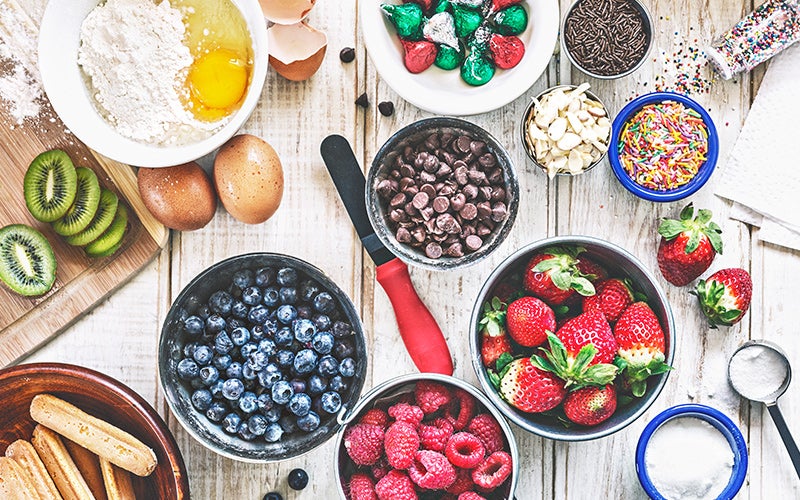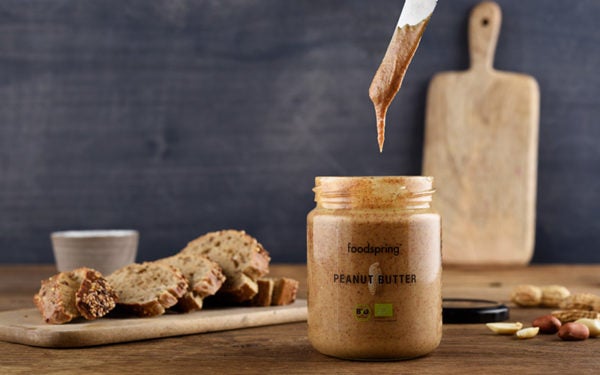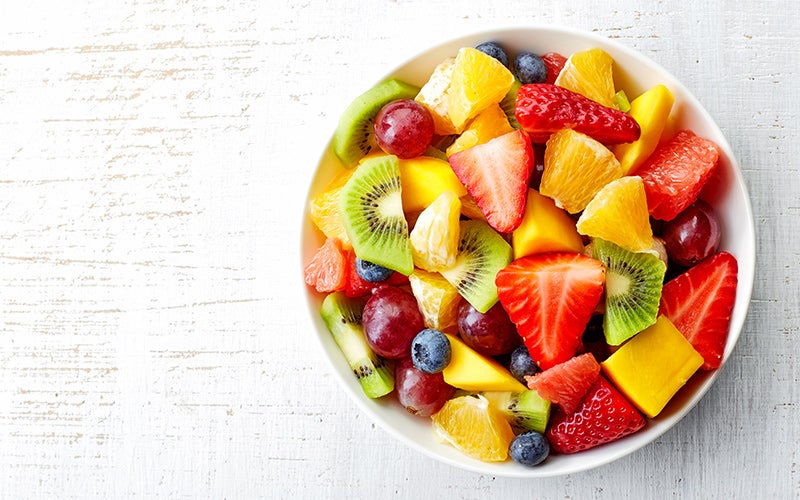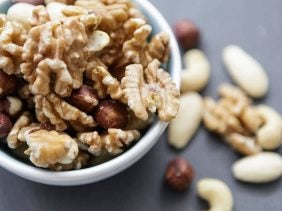5 Days Eating Sugar Free? Let’s Go!
 ©Torresigner
©Torresigner
It’s time to put all the cards on the table: Is it possible to live without sugar? What are the health benefits? You can find out in just five days.
Living and Eating Sugar Free
Our conclusion
- Eating sugar free completely is almost impossible due to the fact that fruits and vegetables contain sugar in natural form.
- The WHO recommends that sugar make up no more than 5% of your daily caloric intake.
- Sugar also has different names. Sometimes the things we eat contain the sneaky sweet stuff without us even realizing it.
- Consciously reducing your sugar consumption can increase your overall awareness of sweet foods and might reduce sugar cravings.
Sugar’s Many Different Names
If it were so easy, we’d eat sugar-free every day. But the sweet stuff has many names, which can make it hard to spot. To make it easier for you to find your way around the supermarket, here is a list of the names most commonly used:
- Red or brown sugar
- Fructose
- Table sugar/saccharose
- Inverted sugar syrup
- Isomaltulose
- Corn syrup, also known as isoglucose
- Malt sugar, or maltose
- Molasses
- Lactose
- Sorbitol, or glucitol
- Glucose, or dextrose
- Cane sugar
- White sugar
Challenge Accepted! 5 Days Sugar-Free
Fruit-flavored yogurts
While it might seem like a fruit-flavored yogurt would obviously be less sugary than a chocolate mousse, that’s not always the case. If you look at the ingredients list, you’ll almost always notice that there’s a lot of added sweetness in that so-called healthy snack. And yes, added fructose counts as added sugar too.
Peanut butter
While peanut butter is normally considered a healthy product thanks to being both protein- and fiber-rich, many popular peanut butter brands contain a shocking amount of sugar. Not our peanut butter, though. Each jar is made with 100% real, organic peanuts (350 in each one, to be precise) as well as 30 grams of protein, 8.5 grams of fiber, and meanwhile, 0 grams of sugar. Yup, you read that right.

Discover our organic peanut butter
Tea-based drinks
Tea-based drinks are frequently considered a better alternative to sugary sodas, mostly because tea is thought to be generally good for your health. While that’s true, many industrial tea-based drinks contain a perplexing amount of added sweeteners, usually in the form of honey. On the other hand, our delicious peach iced tea recipe is refreshing all on its own.
Sugar’s Many Different Names
If it were so easy, we’d eat sugar-free every day. But the sweet stuff has many names, which can make it hard to spot. To make it easier for you to find your way around the supermarket, here is a list of the names most commonly used:
- Red or brown sugar
- Fructose
- Table sugar/saccharose
- Inverted sugar syrup
- Isomaltulose
- Corn syrup, also known as isoglucose
- Malt sugar, or maltose
- Molasses
- Lactose
- Sorbitol, or glucitol
- Glucose, or dextrose
- Cane sugar
- White sugar
Challenge Accepted! 5 Days Sugar-Free
Protein and healthy fats are the basics to just about any healthy and balanced diet. To achieve this, though, it is almost impossible to eat completely sugar-free. Yes, even fruits and vegetables contain natural fructose. And due to our high consumption of additional sugary foods, many of us often exceed the daily recommended amount.
The only way to become aware of exactly how much sugar you’re eating is to track it for just a little while. Thanks to our 5-day sugar-free challenge, you now have all the information and recipes to get started. To start as soon as possible, download our free 5-day nutrition program. You will find recipes to go sugar-free along with all the nutritional information you need. We have based the program on an average of 2000 calories per day. And we’ve prepared a free shopping list for you, too.
Our conclusion
- Eating sugar free completely is almost impossible due to the fact that fruits and vegetables contain sugar in natural form.
- The WHO recommends that sugar make up no more than 5% of your daily caloric intake.
- Sugar also has different names. Sometimes the things we eat contain the sneaky sweet stuff without us even realizing it.
- Consciously reducing your sugar consumption can increase your overall awareness of sweet foods and might reduce sugar cravings.
According to the World Health Organization (WHO), added sugar should make up no more than 5% of your daily caloric intake. Something is classified as an added sugar whenever it’s unnecessarily added to food by a manufacturer, cook, or consumer, and it includes everything from monosaccharides like glucose and fructose to disaccharides like sucrose and industrial sugar.
Honey, syrup, fruit juices, and concentrates can also contain added sugars. Natural sugars, which naturally occur in fresh fruits and vegetables, dairy, and whole grain products, are not included in this tally, as the WHO has determined they do not have an adverse effect on your health.
Fruit-flavored yogurts
While it might seem like a fruit-flavored yogurt would obviously be less sugary than a chocolate mousse, that’s not always the case. If you look at the ingredients list, you’ll almost always notice that there’s a lot of added sweetness in that so-called healthy snack. And yes, added fructose counts as added sugar too.
Peanut butterWhile peanut butter is normally considered a healthy product thanks to being both protein- and fiber-rich, many popular peanut butter brands contain a shocking amount of sugar. Not our peanut butter, though. Each jar is made with 100% real, organic peanuts (350 in each one, to be precise) as well as 30 grams of protein, 8.5 grams of fiber, and meanwhile, 0 grams of sugar. Yup, you read that right.
 ©foodspring
©foodspring Discover our organic peanut butter
Tea-based drinks
Tea-based drinks are frequently considered a better alternative to sugary sodas, mostly because tea is thought to be generally good for your health. While that’s true, many industrial tea-based drinks contain a perplexing amount of added sweeteners, usually in the form of honey. On the other hand, our delicious peach iced tea recipe is refreshing all on its own.
Sugar’s Many Different Names
If it were so easy, we’d eat sugar-free every day. But the sweet stuff has many names, which can make it hard to spot. To make it easier for you to find your way around the supermarket, here is a list of the names most commonly used:
- Red or brown sugar
- Fructose
- Table sugar/saccharose
- Inverted sugar syrup
- Isomaltulose
- Corn syrup, also known as isoglucose
- Malt sugar, or maltose
- Molasses
- Lactose
- Sorbitol, or glucitol
- Glucose, or dextrose
- Cane sugar
- White sugar
Challenge Accepted! 5 Days Sugar-Free
Protein and healthy fats are the basics to just about any healthy and balanced diet. To achieve this, though, it is almost impossible to eat completely sugar-free. Yes, even fruits and vegetables contain natural fructose. And due to our high consumption of additional sugary foods, many of us often exceed the daily recommended amount.
The only way to become aware of exactly how much sugar you’re eating is to track it for just a little while. Thanks to our 5-day sugar-free challenge, you now have all the information and recipes to get started. To start as soon as possible, download our free 5-day nutrition program. You will find recipes to go sugar-free along with all the nutritional information you need. We have based the program on an average of 2000 calories per day. And we’ve prepared a free shopping list for you, too.
Our conclusion
- Eating sugar free completely is almost impossible due to the fact that fruits and vegetables contain sugar in natural form.
- The WHO recommends that sugar make up no more than 5% of your daily caloric intake.
- Sugar also has different names. Sometimes the things we eat contain the sneaky sweet stuff without us even realizing it.
- Consciously reducing your sugar consumption can increase your overall awareness of sweet foods and might reduce sugar cravings.
For many of us, it’s all too common to eat more sugar than we need every day, because it’s easy to forget that sugar is hiding everywhere. Often, we’re eating something that seems healthy without even realizing it’s secretly chock-full of the sweet stuff.
It’s time to clear the air. Saying no to sugar for just five days will help you become more aware of your overall consumption and meaningfully reduce your sugar intake in the future.
According to the World Health Organization (WHO), added sugar should make up no more than 5% of your daily caloric intake. Something is classified as an added sugar whenever it’s unnecessarily added to food by a manufacturer, cook, or consumer, and it includes everything from monosaccharides like glucose and fructose to disaccharides like sucrose and industrial sugar.
Honey, syrup, fruit juices, and concentrates can also contain added sugars. Natural sugars, which naturally occur in fresh fruits and vegetables, dairy, and whole grain products, are not included in this tally, as the WHO has determined they do not have an adverse effect on your health.

How to go sugar-free
Natural sugar is found in many foods: in fruit in the form of fructose or in milk as lactose. That’s why it’s almost impossible to cut it out of your diet completely. Our 5-day sugar-free challenge aims to battle the rapid increase in sugar consumption. But sometimes it hides in surprising places, especially in processed foods where we would never expect to find it at all.
Top 5 Sugar Traps
Bread
Whether fresh or packaged, all it takes is a quick glance at the ingredient list to realize that sugars are often added to bread. In fact, malt extract, malt syrup, and caramel syrup are sometimes used to make whole grain bread look darker, and therefore healthier, than white bread. Let that one sink in for a minute.
Our vegan Protein Bread not only comes to you completely sugar-free but also gives you a much bigger portion of protein with fewer calories. Bring the bakery home to you with an extra kick of power for your muscles!
Muesli
Industrial mueslis are one of many sugar traps hiding at the supermarket. Take a look at the nutritional values behind the healthy-seeming “whole” and “crispy muesli” options that line the aisles. In addition to whole oats, added sugars are often found in the form of fructose.Fruit-flavored yogurtsWhile it might seem like a fruit-flavored yogurt would obviously be less sugary than a chocolate mousse, that’s not always the case. If you look at the ingredients list, you’ll almost always notice that there’s a lot of added sweetness in that so-called healthy snack. And yes, added fructose counts as added sugar too.
Peanut butter While peanut butter is normally considered a healthy product thanks to being both protein- and fiber-rich, many popular peanut butter brands contain a shocking amount of sugar. Not our peanut butter, though. Each jar is made with 100% real, organic peanuts (350 in each one, to be precise) as well as 30 grams of protein, 8.5 grams of fiber, and meanwhile, 0 grams of sugar. Yup, you read that right.
Tea-based drinks
Tea-based drinks are frequently considered a better alternative to sugary sodas, mostly because tea is thought to be generally good for your health. While that’s true, many industrial tea-based drinks contain a perplexing amount of added sweeteners, usually in the form of honey. On the other hand, our delicious peach iced tea recipe is refreshing all on its own.
Sugar’s Many Different Names
If it were so easy, we’d eat sugar-free every day. But the sweet stuff has many names, which can make it hard to spot. To make it easier for you to find your way around the supermarket, here is a list of the names most commonly used:
- Red or brown sugar
- Fructose
- Table sugar/saccharose
- Inverted sugar syrup
- Isomaltulose
- Corn syrup, also known as isoglucose
- Malt sugar, or maltose
- Molasses
- Lactose
- Sorbitol, or glucitol
- Glucose, or dextrose
- Cane sugar
- White sugar
Challenge Accepted! 5 Days Sugar-Free
Protein and healthy fats are the basics to just about any healthy and balanced diet. To achieve this, though, it is almost impossible to eat completely sugar-free. Yes, even fruits and vegetables contain natural fructose. And due to our high consumption of additional sugary foods, many of us often exceed the daily recommended amount.The only way to become aware of exactly how much sugar you’re eating is to track it for just a little while. Thanks to our 5-day sugar-free challenge, you now have all the information and recipes to get started. To start as soon as possible, download our free 5-day nutrition program. You will find recipes to go sugar-free along with all the nutritional information you need. We have based the program on an average of 2000 calories per day. And we’ve prepared a free shopping list for you, too.
Our conclusion
- Eating sugar free completely is almost impossible due to the fact that fruits and vegetables contain sugar in natural form.
- The WHO recommends that sugar make up no more than 5% of your daily caloric intake.
- Sugar also has different names. Sometimes the things we eat contain the sneaky sweet stuff without us even realizing it.
- Consciously reducing your sugar consumption can increase your overall awareness of sweet foods and might reduce sugar cravings.
Sources for this article
We at foodspring use only high-quality sources, including peer-reviewed studies, to support the facts within our articles. Read our editorial policy to learn more about how we fact-check and keep our content accurate, reliable, and trustworthy.
Challenge Accepted! 5 Days Sugar-Free
Protein and healthy fats are the basics to just about any healthy and balanced diet. To achieve this, though, it is almost impossible to eat completely sugar-free. Yes, even fruits and vegetables contain natural fructose. And due to our high consumption of additional sugary foods, many of us often exceed the daily recommended amount.
The only way to become aware of exactly how much sugar you’re eating is to track it for just a little while. Thanks to our 5-day sugar-free challenge, you now have all the information and recipes to get started. To start as soon as possible, download our free 5-day nutrition program. You will find recipes to go sugar-free along with all the nutritional information you need. We have based the program on an average of 2000 calories per day. And we’ve prepared a free shopping list for you, too.
Our conclusion
- Eating sugar free completely is almost impossible due to the fact that fruits and vegetables contain sugar in natural form.
- The WHO recommends that sugar make up no more than 5% of your daily caloric intake.
- Sugar also has different names. Sometimes the things we eat contain the sneaky sweet stuff without us even realizing it.
- Consciously reducing your sugar consumption can increase your overall awareness of sweet foods and might reduce sugar cravings.
Sugar’s Many Different Names
If it were so easy, we’d eat sugar-free every day. But the sweet stuff has many names, which can make it hard to spot. To make it easier for you to find your way around the supermarket, here is a list of the names most commonly used:
- Red or brown sugar
- Fructose
- Table sugar/saccharose
- Inverted sugar syrup
- Isomaltulose
- Corn syrup, also known as isoglucose
- Malt sugar, or maltose
- Molasses
- Lactose
- Sorbitol, or glucitol
- Glucose, or dextrose
- Cane sugar
- White sugar
Challenge Accepted! 5 Days Sugar-Free
Fruit-flavored yogurts
While it might seem like a fruit-flavored yogurt would obviously be less sugary than a chocolate mousse, that’s not always the case. If you look at the ingredients list, you’ll almost always notice that there’s a lot of added sweetness in that so-called healthy snack. And yes, added fructose counts as added sugar too.
Peanut butter
While peanut butter is normally considered a healthy product thanks to being both protein- and fiber-rich, many popular peanut butter brands contain a shocking amount of sugar. Not our peanut butter, though. Each jar is made with 100% real, organic peanuts (350 in each one, to be precise) as well as 30 grams of protein, 8.5 grams of fiber, and meanwhile, 0 grams of sugar. Yup, you read that right.

Discover our organic peanut butter
Tea-based drinks
Tea-based drinks are frequently considered a better alternative to sugary sodas, mostly because tea is thought to be generally good for your health. While that’s true, many industrial tea-based drinks contain a perplexing amount of added sweeteners, usually in the form of honey. On the other hand, our delicious peach iced tea recipe is refreshing all on its own.
Sugar’s Many Different Names
If it were so easy, we’d eat sugar-free every day. But the sweet stuff has many names, which can make it hard to spot. To make it easier for you to find your way around the supermarket, here is a list of the names most commonly used:
- Red or brown sugar
- Fructose
- Table sugar/saccharose
- Inverted sugar syrup
- Isomaltulose
- Corn syrup, also known as isoglucose
- Malt sugar, or maltose
- Molasses
- Lactose
- Sorbitol, or glucitol
- Glucose, or dextrose
- Cane sugar
- White sugar
Challenge Accepted! 5 Days Sugar-Free
Protein and healthy fats are the basics to just about any healthy and balanced diet. To achieve this, though, it is almost impossible to eat completely sugar-free. Yes, even fruits and vegetables contain natural fructose. And due to our high consumption of additional sugary foods, many of us often exceed the daily recommended amount.
The only way to become aware of exactly how much sugar you’re eating is to track it for just a little while. Thanks to our 5-day sugar-free challenge, you now have all the information and recipes to get started. To start as soon as possible, download our free 5-day nutrition program. You will find recipes to go sugar-free along with all the nutritional information you need. We have based the program on an average of 2000 calories per day. And we’ve prepared a free shopping list for you, too.
Our conclusion
- Eating sugar free completely is almost impossible due to the fact that fruits and vegetables contain sugar in natural form.
- The WHO recommends that sugar make up no more than 5% of your daily caloric intake.
- Sugar also has different names. Sometimes the things we eat contain the sneaky sweet stuff without us even realizing it.
- Consciously reducing your sugar consumption can increase your overall awareness of sweet foods and might reduce sugar cravings.
According to the World Health Organization (WHO), added sugar should make up no more than 5% of your daily caloric intake. Something is classified as an added sugar whenever it’s unnecessarily added to food by a manufacturer, cook, or consumer, and it includes everything from monosaccharides like glucose and fructose to disaccharides like sucrose and industrial sugar.
Honey, syrup, fruit juices, and concentrates can also contain added sugars. Natural sugars, which naturally occur in fresh fruits and vegetables, dairy, and whole grain products, are not included in this tally, as the WHO has determined they do not have an adverse effect on your health.
Fruit-flavored yogurts
While it might seem like a fruit-flavored yogurt would obviously be less sugary than a chocolate mousse, that’s not always the case. If you look at the ingredients list, you’ll almost always notice that there’s a lot of added sweetness in that so-called healthy snack. And yes, added fructose counts as added sugar too.
Peanut butterWhile peanut butter is normally considered a healthy product thanks to being both protein- and fiber-rich, many popular peanut butter brands contain a shocking amount of sugar. Not our peanut butter, though. Each jar is made with 100% real, organic peanuts (350 in each one, to be precise) as well as 30 grams of protein, 8.5 grams of fiber, and meanwhile, 0 grams of sugar. Yup, you read that right.
 ©foodspring
©foodspring Discover our organic peanut butter
Tea-based drinks
Tea-based drinks are frequently considered a better alternative to sugary sodas, mostly because tea is thought to be generally good for your health. While that’s true, many industrial tea-based drinks contain a perplexing amount of added sweeteners, usually in the form of honey. On the other hand, our delicious peach iced tea recipe is refreshing all on its own.
Sugar’s Many Different Names
If it were so easy, we’d eat sugar-free every day. But the sweet stuff has many names, which can make it hard to spot. To make it easier for you to find your way around the supermarket, here is a list of the names most commonly used:
- Red or brown sugar
- Fructose
- Table sugar/saccharose
- Inverted sugar syrup
- Isomaltulose
- Corn syrup, also known as isoglucose
- Malt sugar, or maltose
- Molasses
- Lactose
- Sorbitol, or glucitol
- Glucose, or dextrose
- Cane sugar
- White sugar
Challenge Accepted! 5 Days Sugar-Free
Protein and healthy fats are the basics to just about any healthy and balanced diet. To achieve this, though, it is almost impossible to eat completely sugar-free. Yes, even fruits and vegetables contain natural fructose. And due to our high consumption of additional sugary foods, many of us often exceed the daily recommended amount.
The only way to become aware of exactly how much sugar you’re eating is to track it for just a little while. Thanks to our 5-day sugar-free challenge, you now have all the information and recipes to get started. To start as soon as possible, download our free 5-day nutrition program. You will find recipes to go sugar-free along with all the nutritional information you need. We have based the program on an average of 2000 calories per day. And we’ve prepared a free shopping list for you, too.
Our conclusion
- Eating sugar free completely is almost impossible due to the fact that fruits and vegetables contain sugar in natural form.
- The WHO recommends that sugar make up no more than 5% of your daily caloric intake.
- Sugar also has different names. Sometimes the things we eat contain the sneaky sweet stuff without us even realizing it.
- Consciously reducing your sugar consumption can increase your overall awareness of sweet foods and might reduce sugar cravings.
For many of us, it’s all too common to eat more sugar than we need every day, because it’s easy to forget that sugar is hiding everywhere. Often, we’re eating something that seems healthy without even realizing it’s secretly chock-full of the sweet stuff.
It’s time to clear the air. Saying no to sugar for just five days will help you become more aware of your overall consumption and meaningfully reduce your sugar intake in the future.
According to the World Health Organization (WHO), added sugar should make up no more than 5% of your daily caloric intake. Something is classified as an added sugar whenever it’s unnecessarily added to food by a manufacturer, cook, or consumer, and it includes everything from monosaccharides like glucose and fructose to disaccharides like sucrose and industrial sugar.
Honey, syrup, fruit juices, and concentrates can also contain added sugars. Natural sugars, which naturally occur in fresh fruits and vegetables, dairy, and whole grain products, are not included in this tally, as the WHO has determined they do not have an adverse effect on your health.

How to go sugar-free
Natural sugar is found in many foods: in fruit in the form of fructose or in milk as lactose. That’s why it’s almost impossible to cut it out of your diet completely. Our 5-day sugar-free challenge aims to battle the rapid increase in sugar consumption. But sometimes it hides in surprising places, especially in processed foods where we would never expect to find it at all.
Top 5 Sugar Traps
Bread
Whether fresh or packaged, all it takes is a quick glance at the ingredient list to realize that sugars are often added to bread. In fact, malt extract, malt syrup, and caramel syrup are sometimes used to make whole grain bread look darker, and therefore healthier, than white bread. Let that one sink in for a minute.
Our vegan Protein Bread not only comes to you completely sugar-free but also gives you a much bigger portion of protein with fewer calories. Bring the bakery home to you with an extra kick of power for your muscles!
Muesli
Industrial mueslis are one of many sugar traps hiding at the supermarket. Take a look at the nutritional values behind the healthy-seeming “whole” and “crispy muesli” options that line the aisles. In addition to whole oats, added sugars are often found in the form of fructose.Fruit-flavored yogurtsWhile it might seem like a fruit-flavored yogurt would obviously be less sugary than a chocolate mousse, that’s not always the case. If you look at the ingredients list, you’ll almost always notice that there’s a lot of added sweetness in that so-called healthy snack. And yes, added fructose counts as added sugar too.
Peanut butter While peanut butter is normally considered a healthy product thanks to being both protein- and fiber-rich, many popular peanut butter brands contain a shocking amount of sugar. Not our peanut butter, though. Each jar is made with 100% real, organic peanuts (350 in each one, to be precise) as well as 30 grams of protein, 8.5 grams of fiber, and meanwhile, 0 grams of sugar. Yup, you read that right.
Tea-based drinks
Tea-based drinks are frequently considered a better alternative to sugary sodas, mostly because tea is thought to be generally good for your health. While that’s true, many industrial tea-based drinks contain a perplexing amount of added sweeteners, usually in the form of honey. On the other hand, our delicious peach iced tea recipe is refreshing all on its own.
Sugar’s Many Different Names
If it were so easy, we’d eat sugar-free every day. But the sweet stuff has many names, which can make it hard to spot. To make it easier for you to find your way around the supermarket, here is a list of the names most commonly used:
- Red or brown sugar
- Fructose
- Table sugar/saccharose
- Inverted sugar syrup
- Isomaltulose
- Corn syrup, also known as isoglucose
- Malt sugar, or maltose
- Molasses
- Lactose
- Sorbitol, or glucitol
- Glucose, or dextrose
- Cane sugar
- White sugar
Challenge Accepted! 5 Days Sugar-Free
Protein and healthy fats are the basics to just about any healthy and balanced diet. To achieve this, though, it is almost impossible to eat completely sugar-free. Yes, even fruits and vegetables contain natural fructose. And due to our high consumption of additional sugary foods, many of us often exceed the daily recommended amount.The only way to become aware of exactly how much sugar you’re eating is to track it for just a little while. Thanks to our 5-day sugar-free challenge, you now have all the information and recipes to get started. To start as soon as possible, download our free 5-day nutrition program. You will find recipes to go sugar-free along with all the nutritional information you need. We have based the program on an average of 2000 calories per day. And we’ve prepared a free shopping list for you, too.
Our conclusion
- Eating sugar free completely is almost impossible due to the fact that fruits and vegetables contain sugar in natural form.
- The WHO recommends that sugar make up no more than 5% of your daily caloric intake.
- Sugar also has different names. Sometimes the things we eat contain the sneaky sweet stuff without us even realizing it.
- Consciously reducing your sugar consumption can increase your overall awareness of sweet foods and might reduce sugar cravings.
Sources for this article
We at foodspring use only high-quality sources, including peer-reviewed studies, to support the facts within our articles. Read our editorial policy to learn more about how we fact-check and keep our content accurate, reliable, and trustworthy.

































